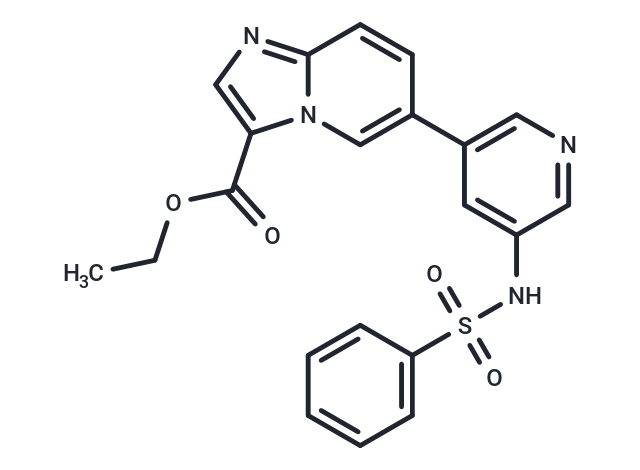Shopping Cart
- Remove All
 Your shopping cart is currently empty
Your shopping cart is currently empty
HS-173 is an effective PI3Kα inhibitor (IC50: 0.8 nM).

| Pack Size | Price | Availability | Quantity |
|---|---|---|---|
| 1 mg | $34 | In Stock | |
| 5 mg | $77 | In Stock | |
| 10 mg | $123 | In Stock | |
| 25 mg | $228 | In Stock | |
| 50 mg | $372 | In Stock | |
| 100 mg | $548 | In Stock | |
| 1 mL x 10 mM (in DMSO) | $84 | In Stock |
| Description | HS-173 is an effective PI3Kα inhibitor (IC50: 0.8 nM). |
| Targets&IC50 | PI3Kα:0.8 nM |
| In vitro | By inhibiting the PI3K/Akt signaling pathway, HS-173 significantly slows down the progression of liver fibrosis in vivo. It also reduces angiogenesis in mice. |
| In vivo | In vitro studies reveal that HS-173 can induce apoptosis by affecting cell cycle distribution and activating caspases, while also inhibiting VEGF-induced angiogenesis. When combined with sorafenib, HS-173 exhibits synergistic anticancer effects in pancreatic cancer cells. Additionally, HS-173 demonstrates significant anti-proliferative activity in T47D, SK-BR3, and MCF7 cells (IC50: 0.6/1.5/7.8 μM), and fully inhibits the PI3K pathway in cancer cell lines (Hep3B and SkBr3). |
| Kinase Assay | PI3-Kinase assay: The PI3K assay is performed using the Kinase-Glo Max luminescent kinase assay kit which quantifies the amount of ADP produced by the PI3K reaction. In brief, an active PI3K (100 ng) is preincubated with compound for 5 min in kinase reaction buffer (25 mM MOPS [pH 7.0], 5 mM MgCl2, and 1 mM EGTA) and 10 μg l-α-phosphatidylinositol (PI). Before addition of PI, it is sonicated with sonication buffer (25 mM MOPS [pH 7.0], 1 mM EGTA) in water for 20 min for allowing miscelle formation. Then reaction is started by the addition of 10 μM ATP and ran for 180 min. To terminate kinase reaction, same volume of Kinase-Glo Max buffer is added. After 10 min, the plates are then read on a GloMax plate reader for luminescence detection. |
| Cell Research | Cell viability is performed by a MTT assay. Briefly, T47D cells are plated in 96-well plates for 24 h. Then, the medium is removed and cells were treated with either DMSO as a control or various concentrations of inhibitors. The final concentration of DMSO in the medium was ≤0.1% (v/v). After the cells are incubated for 48 h, 20 μL MTT solution (5 mg/mL) is added to each well for another 4 h at 37 °C. The formazan crystals that formed are dissolved in DMSO (100 μL/well) by constant shaking for 5 min. The plate is then read on a microplate reader at 540 nm. Three replicate wells are used for each analysis. The median inhibitory concentration (IC50, defined as the drug concentration at which cell growth is inhibited by 50%) is assessed from the dose?response curves. To assess the effect of compounds on cell proliferation, T47D cells are cultured with compound (0.1?100 μM) for 48 h before MTT analysis.(Only for Reference) |
| Synonyms | HS173, HS 173 |
| Molecular Weight | 422.46 |
| Formula | C21H18N4O4S |
| Cas No. | 1276110-06-5 |
| Smiles | CCOC(=O)c1cnc2ccc(cn12)-c1cncc(NS(=O)(=O)c2ccccc2)c1 |
| Relative Density. | 1.38 g/cm3 (Predicted) |
| Storage | Powder: -20°C for 3 years | In solvent: -80°C for 1 year | Shipping with blue ice/Shipping at ambient temperature. | |||||||||||||||||||||||||||||||||||
| Solubility Information | DMSO: 78 mg/mL (184.63 mM), Sonication is recommended. H2O: < 1 mg/mL (insoluble or slightly soluble) Ethanol: < 1 mg/mL (insoluble or slightly soluble) | |||||||||||||||||||||||||||||||||||
Solution Preparation Table | ||||||||||||||||||||||||||||||||||||
DMSO
| ||||||||||||||||||||||||||||||||||||

Copyright © 2015-2025 TargetMol Chemicals Inc. All Rights Reserved.